时间:2024-10-14 20:48

### Exploring Women in English: Language, Culture, and Identity
Language is not merely a tool for communication; it is a mirror that reflects the culture and identity of its speakers. In the case of women in English-speaking societies, their linguistic expressions offer profound insights into their experiences, challenges, and achievements. This exploration aims to delve into how language, culture, and identity intertwine in the lives of women, shedding light on their unique narratives within the English language landscape.
#### Language as a Medium of Expression
震川教育For women, language serves as both a platform for self-expression and a vehicle for challenging societal norms. Through their use of language, women can assert their identities, share personal stories, and advocate for social change. For instance,企业-利丰艺咖啡有限公司 the rise of feminist discourse has been significantly influenced by the way women have reclaimed and redefined traditional language. Terms like "intersectionality, 金华市澳美家地毯有限公司" coined by Kimberlé Crenshaw, highlight the complex interplay of race, gender, and other identities, demonstrating the power of language in articulating nuanced experiences.
#### Cultural Contexts and Linguistic Identities
Women's language use is deeply embedded in cultural contexts, which shape their linguistic practices and identities. In many cultures,枝江恒源点胶设备有限公司 there are specific linguistic patterns or styles associated with femininity, such as the use of more polite forms of address or a greater emphasis on inclusivity. These cultural norms influence not only how women communicate but also how they perceive themselves and others. The study of these linguistic patterns can reveal the ways in which gender roles and expectations are perpetuated or challenged through language.
#### Identity Formation and Social Dynamics
Language plays a crucial role in identity formation, allowing women to construct and negotiate their identities within diverse social settings. This process is often dynamic, reflecting changes in personal beliefs, social relationships, and cultural landscapes. For example, second-generation immigrants may adopt elements of their heritage language while also integrating aspects of the dominant language, creating a unique bilingual or multilingual identity. This linguistic blend not only enriches their personal expression but also contributes to the cultural mosaic of English-speaking societies.
#### Challenges and Opportunities
Despite the empowering aspects of language use for women, they also face significant challenges. Stereotyping and gender biases can limit women's access to certain linguistic resources or discourage them from expressing themselves freely. However, this very challenge also presents an opportunity for linguistic innovation and resistance. Women often find creative ways to navigate these barriers, using humor, metaphor, and other rhetorical strategies to assert their presence and voice.
In conclusion, the exploration of women in English reveals a rich tapestry of linguistic, cultural, and identity dynamics. By understanding how language shapes and is shaped by women's experiences, we gain deeper insights into the complexities of gender, culture, and identity in contemporary society. This understanding is crucial for fostering inclusive environments where all voices, including those of women枝江恒源点胶设备有限公司, are valued and heard.